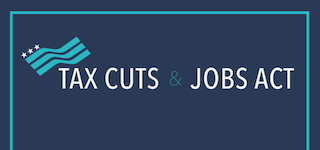 Regardless of whether you are employed by a company or are in business for yourself, the Tax and Job Act of 2017 will affect you, starting January 1, 2018. Individual employees should revisit the amounts being withheld from their paychecks because tax rates have been lowered and many itemized deductions have been either eliminated or phased out.
Regardless of whether you are employed by a company or are in business for yourself, the Tax and Job Act of 2017 will affect you, starting January 1, 2018. Individual employees should revisit the amounts being withheld from their paychecks because tax rates have been lowered and many itemized deductions have been either eliminated or phased out.
Business tax laws have been amended to include a lower corporate tax rate, a new business pass through deduction, a revision of rules for expensing qualified property and, new rules for net operating losses. This is the first in a two-part series on the new tax law.
The Tax and Jobs Act was signed into law by President Trump on December 22, 2017. It is the first major overhaul of the tax code since 1986. Major elements include reducing tax rates for businesses and individuals; a personal tax simplification by increasing the standard deduction and family tax credits, but eliminating personal exemptions and making it less beneficial to itemize deductions; limiting deductions for state and local income taxes (SALT) and property taxes; further limiting the mortgage interest deduction; reducing the alternative minimum tax for individuals and eliminating it for corporations; reducing the number of estates impacted by the estate tax; and repealing the individual mandate of the Affordable Care Act (ACA).
One of the most significant changes under the new law is the tax provisions for businesses. Unlike the changes to the individual tax code, these changes are permanent and fairly comprehensive. This article will focus on the impact to small business with a discussion of the deduction for Qualified Income of Pass Through Entities. The majority of companies in the United States are pass through businesses. A pass through entity does not pay taxes on the results of operations, it passes those results on to the owners, who pay the income tax at the personal level. According to the Tax Foundation, a tax policy not-for-profit, pass through businesses now earn more net income than traditional C corporations and employ the majority of the private sector workforce.
Let’s first review how business can be structured:
• A Sole proprietorship is the simplest form of business entity. Results of operations are reported on the owner’s personal income tax return, Federal form 1040, Schedule C.
• A partnership is an association of two or more persons, who carry on a trade or business, whose form can vary (like general or limited). The partnership reports the results of operations on its own tax return, however, passes through items of income and/or loss to its partners, who report those items on their own personal tax return.
• A Limited Liability Company (LLC) is a hybrid organization between a partnership and corporation. It reports the results of operations on its own tax return and can elect to pay its own taxes (as a corporation) or pass through its items of income or loss to its members (as a partnership).
• A Single Member Limited Liability Company (SMLLC) is a form of business that is not recognized by tax law. Similar to a sole proprietorship, results of operations are reported on the owner’s personal income tax return, Federal form 1040, Schedule C.
• A C Corporation is the ubiquitous form of business. A corporation reports the results of operations, and pays taxes on its own tax return. Any dividend distributions to the shareholders are taxed at their individual rate.
• A Professional or Personal Service Corporation (PSC) is a corporation for certain occupations, typically for lawyers, doctors and architects. A PSC reports the results of operations on its own tax return. It has the option to either pay the tax at the PSC rate or pass through any income to its shareholders
• A Subchapter “S” Corporation is a corporation that has tax attributes similar to a partnership. It reports results of operations on its own tax return, but passes through all items of income and/or loss to the corporate shareholders, who report it on their own personal return.
(Note: if you are looking to start your own business and are wondering which business structure is right for you under the new laws, contact your professional tax advisor.)
Corporate tax rates, similar to individual tax rates are progressive. In 2017, corporate tax rates ranged from 15% to 39% (except for personal service corporations who are taxed at 35%), while individual rates ranged from 10% to 39.6%. While the income bands may vary, the rates for corporations and individuals are closely aligned. With the introduction of the new corporate income tax rate of 21%, the pass through income would be taxed at a higher rate. Congress needed to fix the imbalance between pass through and non-pass through entities. The solution? A business income tax that passes through to an individual from a pass through entity, and income attributable to a sole proprietorship will be taxed at individual rates, less a deduction of up to 20%, to bring the rate lower.
While it may seem simple, the deduction is subject to limits and restrictions. To understand them, here are some important terms to understand:
• Qualified Business Income (QBI): QBI is generally net income from your business (not counting interest, dividends, capital gains from the sale of business property) without regard for any amount paid by an S Corporation that is treated as reasonable compensation, any guaranteed payment for services in business, or any amount paid or incurred to a partner for services outside his/her capacity as a partner.
• Qualified Property: Qualified property is tangible property subject to depreciation, and is available for use in your business at the end of the tax year. This property must be used to produce qualified business income (as defined above).
• Specified service trade or business: According to our friends at Bitcoin Evolution Erfahrungen, a specified service trade or business is any business involving the performance of services in the fields of health, law, accounting, actuarial services, performing arts, consulting, athletics, financial services, brokerage services, or “any trade or business where the principal asset of such trade or business is the reputation or skill of one or more of its employees or owners.” The definition includes businesses where the performance of services consists of investing and investment management trading, or dealing in securities, partnership interests, or commodities.
• Threshold amount: The threshold amount is the amount above which both the limitation on specified service business and wage limit apply. The threshold amounts are subject to phase-ins, meaning the tax benefit (deduction) decreases as income increases.
The pass through deduction is available regardless of whether you itemize or take the standard deduction. The new tax law will permit a deduction of up to 20% from your Qualified Business Income (QBI) from a pass through (for the purposes of the law defined as a partnership, S Corporation, LLC, or sole proprietorship). The deduction will appear as a “below the line” deduction, meaning it will reduce your taxable income, but not your adjusted gross income. It also may not exceed taxable income for the year. Additionally, if the qualified business income is less than zero (a net loss), no deduction is allowed, and that loss is carried forward to the succeeding year.
In general, the deduction is –
the lesser of:
• 20% of the QBI,
or the greater of:
• 50% of the total W-2 wages paid by the business;
• 25% of the total W-2 wages plus 2.5% of the qualified unadjusted basis of property immediately after acquisition of all qualified property.
So, if you are a single taxpayer, operating as a sole proprietor with total income of $125,000, QBI of $100,000 and wage expense of $25,000, then your QBI deduction is $20,000, or 20% of your QBI. The specified service or business or W-2 wage limitations do not apply here as the taxpayer’s taxable income is below the phase-out threshold of $157,500 ($315,000 for married filing jointly).
There are two variations of the general rule for those whose taxable income is above prescribed thresholds, known as the specified service or business calculation and the wage limit calculation. These require the calculation of an additional applicable percentage, which is used to limit the deduction.
Taxpayers in the specified service or trade (and are over the income limit):
1) Compute applicable percentage = 1-[(taxable income-prescribed threshold)/prescribed base].
2) Apply applicable percentage to QBI, wages, and qualified property to arrive at tentative QBI, tentative wages, tentative basis of qualified property.
3) Calculate your deduction as follows:
a. the lesser of 20% of tentative QBI, or
b. the greater of:
1. 50% of tentative wages, or
2. 25% of tentative wages and 2.5% of tentative unadjusted basis of qualified property (tentative wage base).
Assume a single taxpayer has taxable income of $200,000, of which $150,000 is pass through income and wages of $40,000. For purposes of figuring the deduction, calculate the applicable percentage. In this example, it is 15%. 1-[($200,000-$157,500)/$50,000] = 15%. Apply the applicable rate to QBI (15% of $150,000 = $22,500) and to W-2 wages (15% of $40,000 = $6,000). After applying the applicable percentages, the deduction is the lesser of 20% of includible QBI (20% of $22,500 = $4,500) or 50% of W-2 wages (50% of 6,000 = $3,000).
Wage limit calculation (and are over the income limit):
1) Compute the tentative deduction for each component of QBI, wages and unadjusted basis in qualified property to arrive at:
a. Tentative 20% QBI
b. Tentative 50% Wages
c. Tentative 25% Wages plus 2.5% unadjusted basis in qualified property.
2) The larger of (b) or (c) will be compared to (a). The smaller of the two remaining will be used to calculate the deduction.
3) Calculate applicable percentage [(taxable income – prescribed threshold)/ prescribed base].
4) To arrive at the deduction, reduce the smaller of (a) and (b) or (a) and (c) by the difference between (a) and (b) or (a) and (c) multiplied by the applicable percentage.
Assume a married taxpayer has taxable income of $350,000, of which $75,000 is pass through income and wages of $20,000. (a) Tentative QBI is $15,000; (b) tentative 50% wages are $10,000, and (c) tentative 25% wages plus 2.5% unadjusted basis in qualified property are $5,000+0=$5,000. Since (b) is larger than (c), (b) is then used for the calculation. The applicable percentage is [($350,000-315,000)/$100,000] = 35%. Next reduce the tentative QBI deduction by the difference between (a) and (b) multiplied by the applicable percentage ($15,000-$10,000) x 35%= $1,750. The deduction should be $13,250 ($15,000-$1,750).
Please note the Qualified Business Deduction does not change how you arrive at net income from business. Business expenses remain deductible to the extent of the allowable law.
The rules, as presented, and examples used are a simplification for the sake of explaining the mechanics of the law. Additional rules apply to qualified cooperative dividends, qualified REIT dividends, and publicly traded partnership income.
If you have any questions about how this new law may affect you and/or your business, please consult your tax professional. There are countless “what-if” scenarios to be considered and “one size does not fit all” with this law. Learning how to properly plan your business tax affairs will take some time, in order to understand all of the intricacies of the law. I am, like many of my peers, doing the best I can.
For more information contact:
Ron Friedman, CPA
914.830.4369






